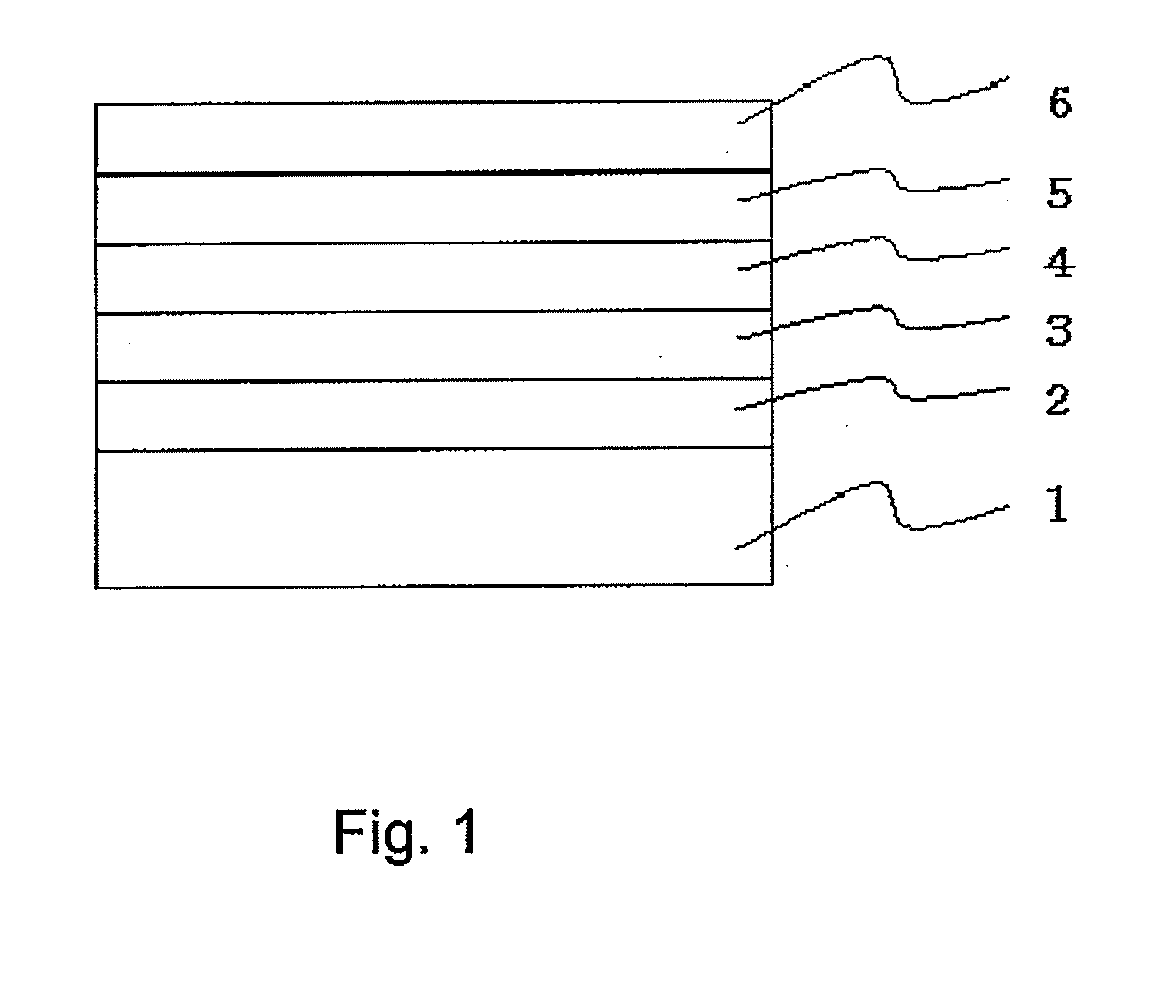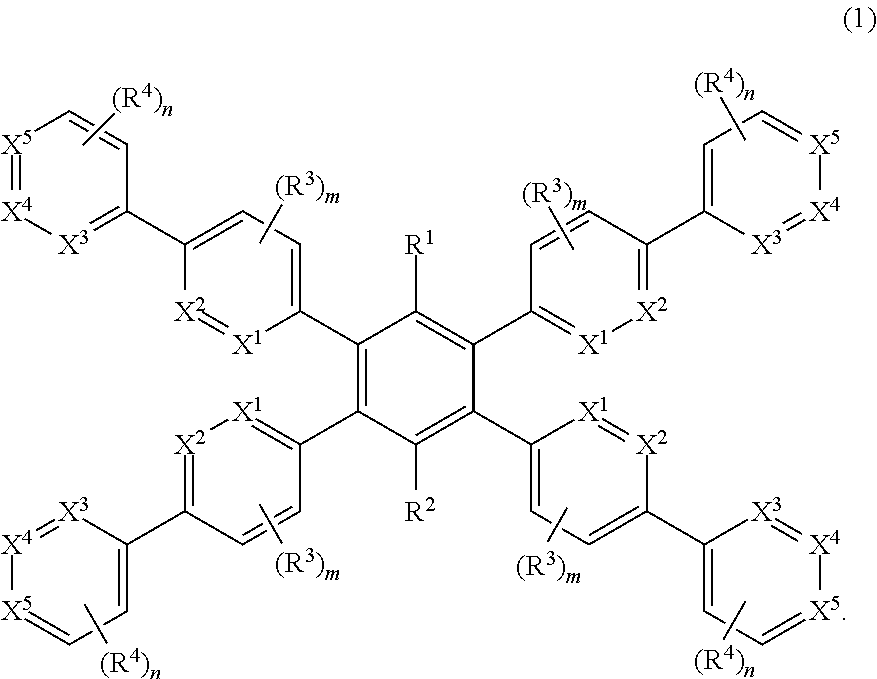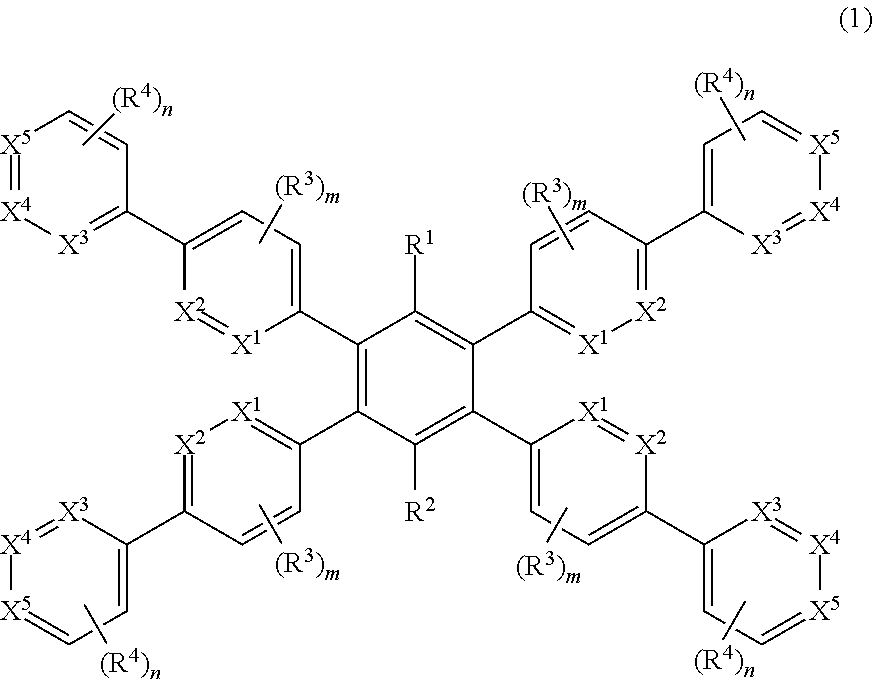1,2,4, 5-substituted phenyl compound, method for producing same and organic electroluminescent device comprising same as constituent
- Summary
- Abstract
- Description
- Claims
- Application Information
AI Technical Summary
Benefits of technology
Problems solved by technology
Method used
Image
Examples
example 1
[0084]
[0085]In a stream of argon, 1.00 g (2.5 mmol) of 1,2,4,5-tetrabromobenzene, 4.04 g (20 mmol) of 4-(2-pyridyl)phenylboric acid, 28.5 mg (0.13 mmol) of palladium acetate, 121 mg (0.25 mmol) of 2-dicyclohexylphosphino-2′,4′,6′-triisopropylbiphenyl, and 5.39 g (25 mmol) of tripotassium phosphate were dissolved in a mixed solvent comprised of 10 mL of toluene and 1 mL of water. The obtained solution was heated under reflux for 44 hours. The reaction mixture was cooled to room temperature, and then, diluted with methanol and the solid was filtered. The thus-obtained crude product was purified by silica gel chromatography using a mixed solvent comprised of chloroform and hexane (2:1˜1:0) as a developing solvent to give 1.38 g of the target 4,4″-di(2-pyridyl)-4′,5′-bis[4-(2-pyridyl)phenyl]-1,1′:2′,1″-terphenyl as a white solid (yield: 79%).
[0086]1H-NMR(CDCl3):δ7.21-7.53(m,4H),7.44(d,J=8.44 Hz,8H), 7.69(s,2H),7.53-7.79(m,8H),7.94(d,J=8.48 Hz,8H),8.70(d,J=4.56 Hz,4H)
example 2
[0087]
[0088]In a stream of argon, 1.00 g (2.5 mmol) of 1,2,4,5-tetrabromobenzene, 4.04 g (20 mmol) of 4-(3-pyridyl)phenylboric acid, 28.5 mg (0.13 mmol) of palladium acetate, 121 mg (0.25 mmol) of 2-dicyclohexylphosphino-2′,4′,6′-triisopropylbiphenyl, and 5.39 g (25 mmol) of tripotassium phosphate were dissolved in a mixed solvent comprised of 20 mL of dioxane and 6 mL of water. The obtained solution was heated under reflux for 21 hours. The reaction mixture was cooled to room temperature, and then, diluted with water and the solid was filtered. The thus-obtained crude product was purified by silica gel chromatography using chloroform as a developing solvent to give 1.35 g of the target 4,4″-di(3-pyridyl)-4′,5′-bis[4-(3-pyridyl)phenyl]-1,1′:2′,1″-terphenyl as a white solid (yield: 77%).
[0089]1H-NMR(CDCl3):δ7.46(d,J=8.28 Hz,8H),7.48-7.56(m,4H), 7.57(d,J=8.32 Hz,8H),7.69(s,2H),8.07(d,J=7.12 Hz,4H),8.63(dd, J=1.48,4.96 Hz,4H),8.92(d,J=1.96 Hz,4H)
example 3
[0090]
[0091]In a stream of argon, 65.9 mg (0.17 mmol) of 1,2,4,5-tetrabromobenzene, 200 mg (1.01 mmol) of 4-(4-pyridyl)phenylboric acid, 1.88 mg (0.0084 mmol) of palladium acetate, 8.60 mg (0.021 mmol) of 2-dicyclohexylphosphino-2′,6′-dimethoxybiphenyl, and 640 mg (3.02 mmol) of tripotassium phosphate were dissolved in 100 mL of toluene. The obtained solution was heated under reflux for 48 hours. The reaction mixture was cooled to room temperature, and then, diluted with 300 mL of chloroform, and the solid was filtered. The obtained organic phase was concentrated, and the thus-obtained crude product was purified by silica gel chromatography using a mixed solvent comprised of chloroform and methanol (99:120:1) as a developing solvent to give 20 mg of the target 4,4″-di(4-pyridyl)-4′,5′-bis[4-(4-pyridyl)-phenyl]-1,1′:2′,1″-terphenyl as a white solid (yield: 17%).
[0092]1H-NMR(CDCl3):δ7.52(s,2H),7.54(d,J=6.21 Hz,8H),7.65(d, J=8.28 Hz,8H),7.85(d,J=8.28 Hz,8H),8.68(d,J=6.21 Hz,8H)
PUM
 Login to View More
Login to View More Abstract
Description
Claims
Application Information
 Login to View More
Login to View More - R&D
- Intellectual Property
- Life Sciences
- Materials
- Tech Scout
- Unparalleled Data Quality
- Higher Quality Content
- 60% Fewer Hallucinations
Browse by: Latest US Patents, China's latest patents, Technical Efficacy Thesaurus, Application Domain, Technology Topic, Popular Technical Reports.
© 2025 PatSnap. All rights reserved.Legal|Privacy policy|Modern Slavery Act Transparency Statement|Sitemap|About US| Contact US: help@patsnap.com



